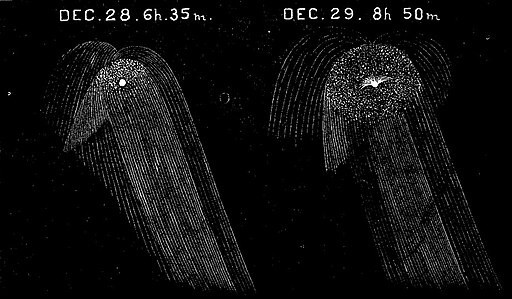Astronomers spotted a comet which experienced a rare volcanic eruption, making it look like it had sprouted a set of bright horns.

Horned Comet
The celestial object named 12P/Pons-Brooks is a comet which revolves around the Sun every 71.3 years. The unusual event was captured by Comet Chasers, a research team headed by Helen Usher of Cardiff/The Open Universities. The Halley-type periodic comet is estimated to measure 34 kilometers long which is equivalent to the size of a city.
It was first discovered by Jean-Louis Pons on July 12, 1812, and then rediscovered independently by William Robert Brooks in 1883, hence its name. It will make its return in 2024 and is expected to reach its maximum brightness that is potentially visible to the naked eye on April 21. Comet 12P/Pons-Brooks is currently in the constellation of Draco and is considered to be the parent body that causes the K-Draconids meteor shower.
The comet itself has been well-known in the scientific community since it was discovered in the 19th century. However, 12P/Pons-Brooks was never perceived as having huge horn-like emissions of light which is around 7,000 times wider than the comet itself.
On July 20, Elek Tamás of Harsona Observatory in Nyiregyhaza, Hungary and other astronomers detected a major outburst from the comet. They observed that 12P/Pons-Brooks appears 100 times brighter than it was the day before. During that moment, the comet has formed two horn-like patterns which resembles the Millennium Falcon spaceship from Star Wars. It was also compared to the saucer section of USS Enterprise aircraft carrier, with the end of the horns looking like the port nacelles.
READ ALSO : 'Star Wars Comet' 12 P/Pons-Brook Is Scheduled for a Total Solar Eclipse After Its 71-Year Orbit
How Did the Comet Get Its Horns?
Comets are celestial bodies that orbit the Sun just like asteroids, but they are made of solid nucleus filled with a mix of frozen gas, dust, and ice. The cosmic snowball is also surrounded by a cloud of gas known as a coma which forms the comet's "tail".
In case of 12P/Pons-Brooks, it not just an ordinary comet because it is categorized as a cryovolcanic comet. This means that it contains high amount of gas and ice build-up which can violently explode. The explosion releases frosty guts called cryomagma which are emitted from the large cracks that formed in the nucleus' shell. Unlike the terrestrial volcano on Earth, the magma spewed by cryovolcanic comets is not an actual magma of molten rocks. Instead, it is a mixture of gases and liquid hydrocarbon.
There are other comets which were found to have cryovolcanos. The most famous of them is 29P/Schwassmann-Wachmann which had several volcanic eruptions and is known for being one of the most volcanically actives objects in the Solar System.
Although there are other cryovolcanic comets in our Solar System, not all of them possess horns like that of 12P/Pons-Brooks. This is due to the fact that this comet has an irregular shape, according to British astronomer and cryovolcanic comet expert Dr. Richard Miles. The irregularity in its shape blocks the gas partially, making them spread elsewhere.
RELATED ARTICLE : Newly Discovered Comet Is Making a Close Approach Toward the Sun; It Becomes as Bright as a Star in 2024, Astronomers Say
Check out more news and information on Comet in Science Times.
© 2025 ScienceTimes.com All rights reserved. Do not reproduce without permission. The window to the world of Science Times.










